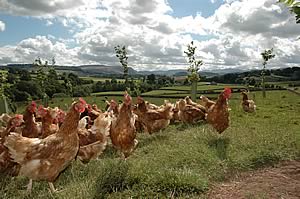 |
|||||||||
|
|||||||||||||||||||
Both
endemic and new virus strains to blame for bird flu recurrence
in Asia's poultry Laboratory confirmation points to both old and new isolates of the bird flu virus as sources of recent HPAI outbreaks in Southeast Asia, says FAO.
Vigorous implementation of recommended control measures is needed to prevent a further spread of the disease and sustain past successes in the region, the Organization warned. Concerned about the recurrence of bird flu in Asia, close monitoring of diagnostic results by FAO has revealed that bird flu is endemic in some areas while new strains have emerged in other places. “Last month’s HPAI outbreak in Thailand’s Pichit province was caused by the same virus strain circulating in the area since 2003/4. The H5N1 virus thus remained alive in central Thailand in a reservoir of birds and poultry, most probably a mix of backyard chicken, ducks and fighting cocks,” said Laurence Gleeson, regional manager of FAO’s bird flu centre in Bangkok today. H5N1 endemic in Thailand's Pichit province This indicates that the H5N1 virus is endemic in the area. While the number and size of outbreaks has been reduced, past control efforts were only partly successful. On the other hand, the outbreaks in Nakhon Phanom and Vientiane were caused by a H5N1 virus strain previously not detected in Thailand and Laos. Instead, the virus is similar to recent isolates from southern China, suggesting that the virus spread from China to Thailand and Laos. Risky cross-border trade continues FAO recognizes that poultry trade across borders is continuing in Southeast and East Asia despite well-known risks to the governments and people in the region. Countries are once more called upon to strengthen in-country as well as cross-border HPAI control measures, FAO added. In addition, regional HPAI networks need to be made stronger and sustainable with national and international support. Recent sharing of information, epidemiological analysis and joint field missions to assess and control outbreaks in poultry have resulted in a better understanding of the month-old resurgence of bird flu in Asian countries such as Cambodia, Laos and Thailand. Bird flu in Indonesia requires greater vigilance “Continuing outbreaks in China, recurrence in Cambodia, Laos and Thailand, and the steady march of the disease in Indonesia underline the need for heightened vigilance in other Asian countries to prevent and detect any resurgence or introduction of the deadly bird flu virus. Timely reporting and sharing information continue to be crucial,” warned He Changchui, FAO’s Regional Representative for Asia and the Pacific. The endemic presence of bird flu over the last three years coupled with the proven inroads of new virus isolates into already affected countries makes a redoubling of efforts at both national and regional level essential, FAO noted. Poorer countries most vulnerable “We are at another critical juncture of fighting against the bird flu situation in the region,” emphasized Mr He. “Some countries can beat back occasional bird flu reoccurrence, but poorer countries still need long-term work – and for that long-term funding is an absolute necessity – to strengthen veterinary services and build up transboundary animal disease containment programmes,” he added. Governments in the region and FAO are working to tackle the bird flu problem at its source, but have so far only received a fraction of the $308.5 million needed. So far, Japan, USAID and the Asian Development Bank are the main donors in the region.
|
|||||||||||||||||||

|
|
||||||||||||||||||
| home | agri-services | pedigree
pen | news | dairy | beef | machinery quota | property | organisations | site map |
|||||||||||||||||||

